
Reading Picture Books with Children: How to Shake Up Storytime and Get Kids Talking about What They See
176
Reading Picture Books with Children: How to Shake Up Storytime and Get Kids Talking about What They See
176Paperback(Reprint)
-
PICK UP IN STORECheck Availability at Nearby Stores
Available within 2 business hours
Related collections and offers
Overview
Traditional storytime often offers a passive experience for kids, but the Whole Book approach asks the youngest of readers to ponder all aspects of a picture book and to use their critical thinking skills. Using classic examples, Megan asks kids to think about why the trim size of Ludwig Bemelman's Madeline is so generous, or why the typeset in David Wiesner's Caldecott winner,The Three Pigs, appears to twist around the page, or why books like Chris Van Allsburg's The Polar Express and Eric Carle's The Very Hungry Caterpillar are printed landscape instead of portrait. The dynamic discussions that result from this shared reading style range from the profound to the hilarious and will inspire adults to make children's responses to text, art, and design an essential part of storytime.

Product Details
| ISBN-13: | 9781580897914 |
|---|---|
| Publisher: | Charlesbridge |
| Publication date: | 03/03/2020 |
| Edition description: | Reprint |
| Pages: | 176 |
| Sales rank: | 188,548 |
| Product dimensions: | 7.40(w) x 8.90(h) x 0.80(d) |
About the Author
Read an Excerpt
Why do we love books so much? Why do some of us, when we’re children, drag around picture books just like stuffed animals? I had a brown monkey—straw-filled—whose hands and feet were many times mended and finally completely re-sewn by my mother. And I had Die fröhlichen Steinzeitkinder (The Stone Age Children) and Die Steinzeit-kinder in Ägypten (The Stone Age Children in Egypt) by Bertil Almqvist (published originally in Swedish). All three objects were essential to my young well-being.
The monkey is gone—I don’t remember when he was lost—but the two books by Mr. Almqvist still stand on my shelves in remarkably good shape. They are the most tangible connection to my childhood self that I have.
Books, like stuffed animals, are things. They’re very thingy. They have a size and a shape. They are more or less shiny, soft or hard, smooth or rough. The paper within them is glossy or matte, brilliant or warm, exciting or comforting.
Megan Dowd Lambert shows us how valuable all this thinginess of books is for students, teachers, and parents. There is a fundamental joy in it. In the classroom and in our homes a picture book is one corner of the triangle completed by the teacher (or parent, or sibling, or friend) and the child. Each is essential. A horror (to my mind) of a modern classroom is the illuminated SMART board in a darkened room. The Very Hungry Caterpillar may look marvelous and big and glowing, but two necessary elements of good education are quite literally left in the dark: the teacher and the student. Learning is best when it comes with a personality, whether that personality is in the line of a brush, the smile of a teacher, or the question of a child.
One way to judge the merit of a work of art is to ask whether it grows more beautiful as it grows older. Reading Picture Books with Children begins by looking at Ludwig Bemelmans’s Madeline. I remember my first reaction to this book: I was thrilled by that loose-painted line, by the simplicity and perfection of the drawing of Madeline herself, and by the wit of the poetry. The line, the drawing, and the poetry have only increased in beauty for me since then.
And this idea of beauty growing over time can be true of the book, the thing itself, too. As an author, to be handed one of my own books that has been torn and taped, smudged and erased, bent and smoothed, the four corners of the cardboard cover separating like little paper pussy willows, is one of my greatest satisfactions. There, in my hand, is the story around the story, the tale of a book that has traveled from hand to hand, mind to mind, heart to heart.
—Chris Raschka
Table of Contents
• Foreword• Preface - Reading with Children
• Introduction - How I learned to Think with My Eyes
• Chapter 1 - That's About the Size of It
Trim Size and Orientation
• Chapter 2 - Coming Attractions
Jackets and Covers
• Chapter 3 - Visual Overtures
Endpapers
• Chapter 4 - Slow Down and Look
Front Matter
• Chapter 5 - Knocked Out by Type
Typography
• Chapter 6 - Gutter Talk and More
Page Design
• Chapter 7 - "Children, Children, What Do You See?"
Nurturing Visual Intelligence
• Chapter 8 - The Picture Book Playground
The Benefits (and Fun) of hte Whole Book Approach
• Conclusion - The Story Continues
• Acknowledgments
• Resources
Leading Whole Book Approach Storytimes
Whole Book Approach Sample Questions
Gloassary of Book and Storytime Terminology
Further Reading
• Notes
• Image Credits
• Index
